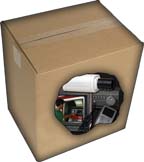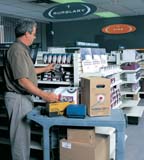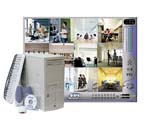
Some manufacturers provide such products under the names of observation systems or kits, which security dealers and systems integrators can then resell to their customers. Other manufacturers prefer to specify each individual job as a system.
Among the advantages of kits are that the components of the entire system arrive at the same time, says Gareth McClean, director of research and development for American Dynamics, San Diego, part of Tyco Fire & Security’s Access Control and Video Systems business unit. Pricing of systems also is simplified, he points out.
“The kits are for somebody who has really simple requirements for dome cameras, not for cameras in explosion-proof housings or a large number of monitors,†McClean asserts. “They, maybe, have a front entrance, a rear entrance, a safe they want to look at.
“In some cases [the end-user] will [install] it themselves, and in some cases they will pay somebody to come in and install,†he declares. “That depends on the personal capabilities of the person installing the equipment, the size of the facility and how much they’re prepared to spend. Complex systems are obviously going to installers and integrators.†McClean thinks people have a tendency to hire installers for jobs with more than four cameras.
American Dynamics sells two types of kits through a major security dealer. The first is actually in a box that can be carried by an installer and includes up to four cameras, a quad monitor, power supplies, lenses, and mounting brackets. It does not usually include housings or a DVR due to size limitations and because these kits are designed mostly for interior use, such as small retail stores. “It really boils down to what physically people can carry with them,†McClean explains.
The more complex kits that security dealers and systems integrators would use cannot necessarily be carried by one person, but all of the components are grouped under a single part number and are delivered at the same time on a pallet or in a box.
Although the kits currently are produced for one installing company, McClean forecasts that they should be available through the company’s regular dealer sales channels by year-end.
Kits Can Minimize Assembly Time
Pelco, Clovis, Calif., offers ImagePaks and DomePaks that are combinations of different components organized for professional security dealers and systems integrators into selection guides. Several different combinations of cameras and lenses can be prepackaged inside bell enclosures and domes, and such kits are assembled for dealers all day by employees, notes Joe Olmstead Jr., Pelco’s director of marketing communications.“The advantages are that the dealer will be able to save time by having this assembled by us and making sure the camera is back-focused and operating as a kit,†Olmstead says.
Dealers confer with the manufacturer’s customer service representatives, tell them what they need for a job, and the company assembles the equipment from the factory for the dealers’ jobs.
“All they have to do is install it,†Olmstead says. “It saves inventory costs to take this box out to a site and not have to assemble all this equipment.â€
Security dealers and systems integrators still would have to understand CCTV installation to align the lenses, and would need to obtain mounting brackets, cabling and other accessories.
“This would not be a complete observation or observer kit – we don’t do that,†Olmstead emphasizes. “Some people do. We do not sell to the end user – it may be our customers [do].†Distributors also may order kits for their dealer customers, he adds.
Panasonic Security Systems’, Secaucus, N.J., Ready-to-Go Camera Kits “come pre-assembled with lens, housing, bracket and camera already installed in one unit and tested, so it is very easy for the installer to just take it out of the box and install,†declares Keith Kanestrin, Panasonic marketing manager.
The kits are given one price, and savings are not so much over the same components priced separately, but in installation time. The company offers 32 different variations of kits, including color/black-and-white, day/night, different types of lenses and housings, indoor/outdoor and fixed or dome cameras.
“We see kits across all types of dealers and distributors, because it’s easier,†Kanestrin emphasizes. “It comes pre-assembled and pretested, and it’s easier to order just one model. We do sell a lot of them.â€
He concedes camera kits are not suited for every type of installation. The company estimates approximately 15 to 20 percent of its camera sales are in kits.
“It definitely depends on the applications,†Kanestrin admits. “There are standard applications that camera packages are perfect for, but depending on the installation, it could vary tremendously.â€

PHOTO COURTESY OF TRI-ED DISTRIBUTION
Bundling – An Option to Kitting
Some manufacturers that do not sell equipment in kits often will “bundle†equipment to ensure that the proper accessories are used.“We bundle the power supply so the installer will use the proper components,†reveals Ramon Duran, vice president of product development for GVI Samsung, Dallas. “We do that with 12-volt systems. With the polarity wrong, you may destroy or damage the product.â€
Although he thinks kits are too limiting, Gary Perlin, vice president of video products at Speco Technologies, Amityville, N.Y., concedes that his company still supplies high-quality kits for some customers.
“We put together DVR kits of higher quality equipment, not the low-end type,†Perlin emphasizes. These include good DVRs, high-resolution color monitors, four good cameras, lenses, mounts and other accessories.
“We don’t put cable in the kits – cable is too limiting,†he insists. “We leave the cabling up to them, since we’re working with professional equipment. It is a kit, but it is not a kit in the typical sense of being a kit.
“We do put together kits for distributors, and they know their customers,†Perlin notes. Each distributors’ kits are assembled to different specifications that are used “to get people in the door – people very seldom buy the kit,†he maintains.
“We sold eight different kits one year ago, and that is now down to two because they’re in the catalog,†Perlin stresses. “We do sell a decent quantity of entry-level [kits]. As long as distributors keep asking, we will do it.
Transmission equipment manufacturer NVT, Menlo Park, Calif., is familiar with the concept of video surveillance kits, although the company does not currently sell any kits. “Kitting is a way to one-stop shop and sometimes is about convenience more than price,†asserts Guy Apple, NVT’s vice president marketing.
Simplifying specification and delivery of video surveillance systems by using kits, bundling or group pricing can help facilitate efficient installations for security dealers and systems integrators, especially those developing their video expertise.
Sidebar: How Your Distributors Can Help
Distributors sometimes have kits assembled for them from the products of participating manufacturers. Other times, the distributor may assemble its own kit based on a dealer’s specifications.Tri-Ed Distribution, Woodbury, N.Y., has systems specialists that help security dealers and systems integrators put together kits for specific jobs.
“Typically the dealer will come in with a specification from his client, and he’ll rely on us to put together the appropriate camera, power supply, lens, DVR and camera configuration that they will need to complete the job,†reports Pat Comunale, Tri-Ed’s COO.
“The advantage is when he gets out to the job site, he knows everything will work, and he’s not going to have to go back for a part that wasn’t configured in the system,†Comunale explains.
He thinks kits are being used by dealers and integrators with long experience and those adding video surveillance to their service offerings. “I think we’re getting calls from both kinds of dealers — guys who don’t have the expertise in the field and those who do have expertise but are looking for different solutions,†Comunale asserts.
ADI, Melville, N.Y., has all sizes of customers for its “consists-of†kits. These are not usually physically packaged in one box but are listed and priced together as a kit in the distributor’s computer system and can be shipped at the same time.
“Typically, it’s a guy who’s doing some sort of mass marketing trying to sell these systems across the country and have contractors all over the country,†explains Nick LaBella, ADI’s director of product management.
The equipment is shipped to a local contractor, who does the installing. “It’s someone who’s looking to do volume using some type of mass marketing – door-knocking, cold-calling, trying to keep it cookie-cutter so the systems are similar and they can train the contractors all on one type of product.â€
Larger installing companies may lease kits to customers for a number of years. Other customers for kits are small security dealers, perhaps those with experience in alarm and fire protection systems who are just getting into video surveillance and haven’t yet developed the in-house expertise to specify systems, LaBella says.
ADI’s “consists-of†kits frequently feature discounts over the same products sold separately. Kits often include four of any of four types of cameras, an LCD flat-screen monitor and a DVR so dealers can mix and match types of cameras for different lighting conditions. Wire, connectors and power supplies may not be included.
“What we try to do is bullet or dome cameras – a self-unitized device so everything is built into it – the camera, lens, bracket and housing,†LaBella notes. “This is not a standard item for us – it’s just through the course of the year, we entertain offers from vendors to do kits.â€
He estimates ADI offers only about a dozen kits annually. “They are instigated by one vendor, unless I see something that is good, I may have to go to two suppliers, but typically I like to keep it with one supplier,†he emphasizes.
That one company should supply a full line of security products. “Once you start mixing in different manufacturers, it gets messy,†LaBella maintains.
Most security dealers and systems integrators do not buy kits frequently because the kits do not offer the flexibility in selection of cameras and other types of equipment that they need. ADI is staying away from observation kits that have everything in one box. LaBella thinks they are aimed more at the do-it-yourself market.
“Our customers would end up with egg on their faces when the same type of product was available at Lowe’s or Home Depot for less money,†he points out. “ADI’s kits are used only by installers or systems integrators.â€
‘Baby Steps’ – Why Some Won’t Kit
Some manufacturers prefer more customized methods of meeting users’ needs than kitting surveillance products.“Historically, we haven’t done kits because our channel partners are very important to us, and we find that their end customers often need different types of things,†explains Robert Siegel, general manager of video solutions for GE Security, Industrial. “We try to work more directly with our dealers, distributors and integrators to see how best to put something together for their customer base.
“To date, we haven’t found high demand for kits,†he stresses. “We try to work closely with our partners to find a solution that is right for the end user.â€
However, Siegel did not rule out the concept of kitting in the future. “We would only do it if we were asked to,†he emphasizes. “When our customers call us, it’s not important what the question is – the answer is, `How high?’ If that’s what the customer asks for, we’ll do it.â€
GVI Samsung, Dallas, has kits for consumers but not for professionals.
“We have tried kits [for professionals] before, but the applications are so different that it’s been a marginal success,†concedes Ramon Duran, GVI Samsung’s vice president of product development. “We don’t have a professional kit that is going to be successful. The combinations are just too many.â€
Although his company still supplies high-quality kits for some customers, Gary Perlin, vice president of video products at Speco Technologies, Amityville, N.Y., maintains his company is getting out of the most basic kits.
“It’s what I call baby’s first CCTV system,†Perlin jokes. “As CCTV systems are getting more sophisticated, the kit concept is becoming less important. People want to exercise their options.
“If you’re using industry-standard equipment, not an observation or mini-system, generally everything fits together,†he observes. “There’s so many options out there – who’s to say whether to use an LCD video monitor, or black-and-white or color, indoor or outdoor, zoom or ultrawide lenses?
“Kits are a good introduction and have a place in the industry, but for professional companies, more and more of us are getting out of it – it’s not where we’re going,†Perlin declares. “They used to be a jumping-off point to go to larger systems. My feeling is when you get into higher quality, you don’t want to be locked into that.â€

Sidebar: Unique System Solutions
One manufacturer has taken a kitting approach to its digital camera system. Each camera is sold with its own DVR.CoVi Technologies, Austin, Texas, offers the Crystal HD nine-piece system designed to run on a network that includes lens, camera, DVR with 150GB of storage and networking software. Cat 5 cable and a personal computer to run the system are not included, but can be if the customer desires.
“The intent of this is to ease the installation of a fine security system, all as one turnkey package,†points out Stuart English, CoVi’s vice president of marketing. He maintains that such a plug-and-play approach is superior to having six vendors shipping individual components to the site. The system carries a single price for each camera-DVR combination.
The system appeals to two categories of people, English explains, “those who have high-value assets that they need to get a better handle on protecting,†and where the high-definition video quality “means you can actually recognize people, gaming chips, money, assets, read a serial number or license plate.
“The other category is people with a highly distributed environment, such as a franchised retail operation where you need to monitor multiple sites across the country so you need a network to allow that to happen,†he notes. Each camera being directly connected to its DVR keeps bandwidth on a company’s network from being consumed, he points out.
Another such product is from CCTV Wholesalers, New Orleans, and is called the PC Witness. Various models can be used by dealers to connect four to 16 surveillance cameras directly to a personal computer’s USB port. The PC Witness Pro is a custom-built personal computer with pre-installed hardware and software.
Such systems benefit from professional installation, maintains Bridget Ehrhardt of CCTV Wholesalers.
The PC Witness Pro from CCTV Wholesalers is a custom-built personal computer with the hardware and software pre-installed to connect four to 16 surveillance cameras directly to the computer’s USB port.